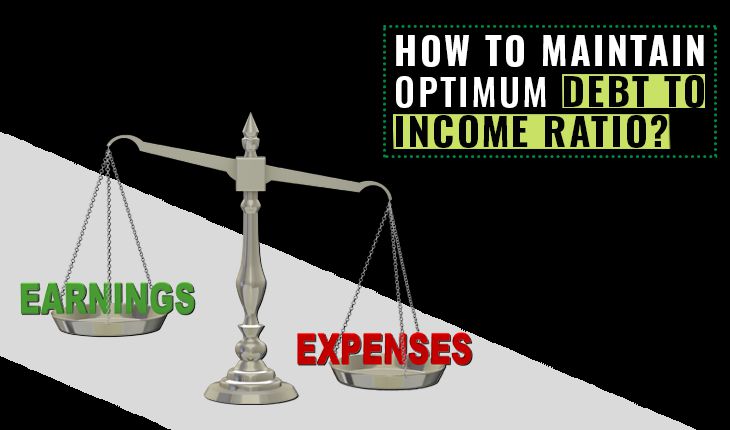How to Maintain Optimum Debt to Income Ratio?

Last Updated : Feb. 23, 2022, 2:48 p.m.
Having a good income and no debt does make you financially strong. But often we have to take loans to meet our aspirations such as home, car, education, etc. It remains good till debt obligations are under control and hurts when they are not. An optimum debt to income ratio is required to live a peaceful financial life. But many may not know the optimum ratio and end up disturbing their budget unknowingly. So, if you’ve any debt now or will take it in the future, read this post where we’ll discuss ways to maintain an optimum debt to income ratio. Let’s check the optimum ratio first.
What is the Optimum Debt to Income Ratio?
The debt to income ratio represents the percentage of the loan and/ credit card dues accounting for your income. Financial advisors suggest debt should not account for more than 10-35% of your income. Top earners can still afford 5-10% extra debt. One also needs to check how much it comes in absolute numbers. That way, you can assess the effect of debt better.
Tips to Ensure Good Debt to Income Ratio
Here’s a list of tips that you can implement to ensure your debt does not explode and cause problems for you later.
Show Discretion Over Credit Card Purchases
Credit cards raise the purchasing power of individuals by allowing them to buy numerous things instantly. But with great purchasing power comes the unwanted debt burden if allowed to revolve it by not paying the dues or paying so partly. Such irresponsible shopping habits pile up your debt at an astronomical rate of 30-40% per annum. It might culminate in you being tagged as a credit card defaulter later.
So, you need to define your shopping limits and adhere to those at all times. Control your temptation to go overboard. See what pain you will get in exchange for impulsive credit card purchases. For example, if you earn INR 40,000 a month, don’t spend more than 4,000-5,000 on your credit card. This way, you can pay that amount on time and stay free of the interest burden. But if you spend say INR 15,000, you may fail to pay the dues entirely and put yourself under a massive debt burden.
Apply for the Loan at the Lowest Interest Rate
Loans can also help meet your financial needs such as education, home, car, vacation, etc. But ensure that comes at the lowest interest rate so that you can pay your monthly EMI obligations on time and meet your other important needs too. Go online, compare the interest rates available and select the lowest one. Of course, your income and credit score needs to be high to merit the lowest rate. You need to have a credit score of more than 750 from either CIBIL or other credit bureaus.
Don’t Go for Unnecessary Loans
Lenders capitalize on your credit-hungry behaviour by dishing out loans for even consumer durables that you can easily buy through your savings. And when you already have credits in your name, such loans are not warranted. The lesser the burden the better it is for you.
